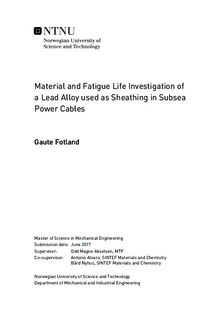Material and Fatigue Life Investigation of a Lead Alloy used as Sheathing in Subsea Power Cables
Master thesis
Permanent lenke
http://hdl.handle.net/11250/2454726Utgivelsesdato
2017Metadata
Vis full innførselSamlinger
Sammendrag
Subsea power cables are used to transport electricity offshore. They consist of several layers, where a lead sheathing is used as the water barrier layer. From reeling and installation, in addition to daily cycles from thermo-mechanical expansion, a subsea power cable is subjected to fatigue, where the lead sheathing is the component failing. Fatigue failure of the lead sheathing could cause complete system failure in a subsea power cable, but still there is no framework for advanced fatigue calculation. It is known that previous fatigue testing of the lead sheathing has provided over-conservative results due to the test specimen geometry used. This thesis was carried out to obtain material characteristics for lead to better understand the failure mechanisms at strain rates from sr = 1E-8 [1/s] to sr = 1E-2 [1/s]. Furthermore an analysis to find the most suitable test specimen geometry for fatigue testing is done. Laboratory experiments have been conducted with a tension test configuration, together with digital image correlation for strain measurement. Numerical simulations have been performed to predict the strain field to decide for the most suitable test specimen geometry. A curved specimen with a short distance between the grips, and interaction between tension and shear forces is found to be favorable. From laboratory testing, it is found that load controlled tests are better when working with lead. Lead is strongly dependent on strain rate, where the stress, in a tension test, decreases with decreasing strain rate. Three different thicknesses of the lead sheathing have been investigated, where a thickness effect has been observed. Furthermore creep is found to strongly affect the material. For the strain rates used in this thesis, there are interaction between creep and fatigue, which causes a severe state in the material. Since creep is temperature dependent, temperature will strongly affect the material behavior. This study will allow for a comparison of different lead alloys, and for less conservative fatigue tests.
